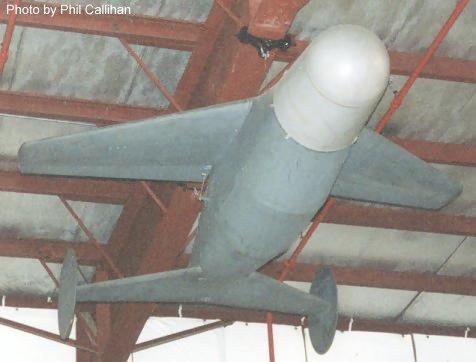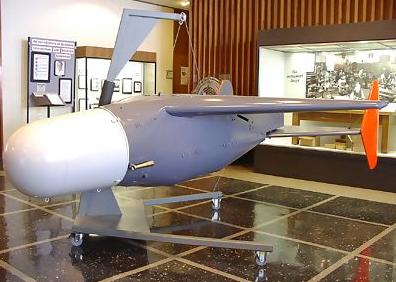Bureau of Standards SWOD MK 9/ASM-N-2 Bat
The Bat was the first successful guided weapon developed by the U.S. Navy, and actually the world's first operational guided missile, which didn't need operator input after launch.
In 1942, the U.S. Navy began the development of radar-guided anti-shipping glide bombs, and one of the first such projects was the Pelican semi-active radar homing missile. Parallel to that, the U.S. Navy developed a glide bomb with an active radar seeker using a similar airframe as the Pelican and a 450 lb (1000 lb) bomb load. Because this missile homed on reflections of signals it had sent out itself, it was called Bat because of these animals' echo-ranging and -homing capability. Bat was originally designated Bomb MK 57, but this was soon changed to SWOD MK 9 (SWOD = Special Weapons Ordnance Device; Pelican became SWOD MK 7). Drop tests of Bat in late 1944 were relatively successful, and the weapon was declared combat ready in January 1945.
 |
| Photo: Phil Callihan |
| ASM-N-2/2a (exact model unknown) |
It was decided that Bat would be employed by PB4Y-2 Privateer long-range patrol bombers. Bat was used against Japanese shipping for the remainder of the war, but the success rate was mediocre at best. While some ships were indeed severly damaged, the drawbacks of the primitive radar seeker also became obvious. When attacking a ship near land (e.g. in port), Bat tended to home on all kinds of unwanted "targets", like docks, mountains, etc. Because of these problems, combat use of the Bat was relatively limited.
About 3000 Bat missiles were produced until the end of World War II, and most of these were still unused in late 1945. There were two versions of Bat, designated SWOD MK 9 MOD 0 (Bat-0) and SWOD MK 9 MOD 1 (Bat-1), but my sources don't mention the specific differences between the variants. In September 1947 and early 1948, the Bat was redesignated as a guided missile:
| Old Designation | September 1947 | ca. February 1948 |
|---|---|---|
| SWOD MK 9 MOD 0 | ASM-2 | ASM-N-2 |
| SWOD MK 9 MOD 1 | ASM-2a | ASM-N-2a |
 |
| Photo: National Institute of Standards & Technology |
| ASM-N-2/2a (exact model unknown) |
In the post-war years, the U.S. Navy tried to improve Bat's accuracy and reliability, but a live test series against an obsolete battleship in 1948 yielded very disappointing results. The latter were in part attributed to radar interference from other ships and aircraft. Because that meant that the ASM-N-2 could be fooled by very simple radar countermeasures, Bat was removed from the inventory in the early 1950s.
Specifications
Note: Data given by several sources show slight variations. Figures given below may therefore be inaccurate!
Data for ASM-N-2:
| Length | 3.63 m (11 ft 11 in) |
| Wingspan | 3.05 m (10 ft) |
| Weight | 850 kg (1880 lb) |
| Speed | 480 km/h (300 mph) |
| Ceiling (max. lanuch) | 8000 m (5 miles) |
| Range | 32 km (20 miles) |
| Propulsion | none |
| Warhead | 450 kg (1000 lb) general-purpose bomb |
Main Sources
[1] Norman Friedman: "US Naval Weapons", Conway Maritime Press, 1983
[2] Frederick I. Ordway III, Ronald C. Wakeford: "International Missile and Spacecraft Guide", McGraw-Hill, 1960
[3] Bill Gunston: "The Illustrated Encyclopedia of Rockets and Missiles", Salamander Books Ltd, 1979
Back to Directory of U.S. Military Rockets and Missiles, Appendix 1
Last Updated: 21 January 2003